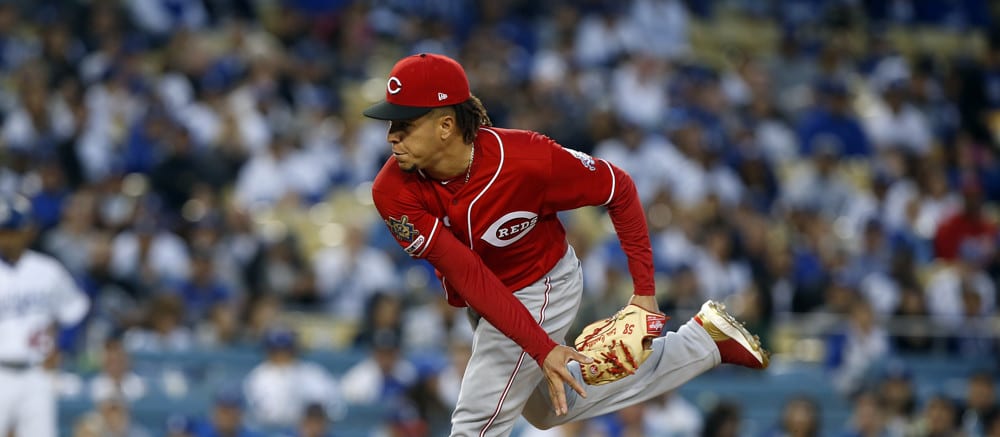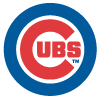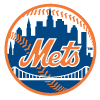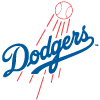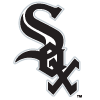This article is part of our Regan's Rumblings series.
To me, swinging strike rate has always been a powerful tool in evaluating starting pitching performance. It's a simple calculation (swings and misses generated divided by total pitches), as it measures both the ability to throw strikes (control) aa well as dominance (causing a hitter to swing and miss). We routinely see the game's best starting pitchers faring well with this metric. For example, in 2018, the NL Cy Young winner (Max Scherzer) led all qualified starters with a 16.2 percent mark, while the AL winner, Blake Snell, finished with a 15.1 percent mark, good for fourth in all of baseball. Sometimes we'll get marginal (or even poor) starters faring well in this category, but for other reasons (poor command or control usually), their overall performance is far from elite. Nick Pivetta (12 percent SwStr% in 2018) was a good example last year, while this season, German Marquez (4.97 ERA) ranks 17th with an excellent 12.9 SwStr%.
This week, I'll be covering the 10 starting pitchers (who qualify for the ERA title) who have showing the biggest first half / second half leap in their SwStr%. Other factors certainly come into play, but an increase in dominances as measured by this metric is certainly a good sign.
SwStr% | |||
| Name | 1H | 2H | Incr. |
| Luis Castillo, Reds | 14.9% | 20.8% | 5.9% |
| Lance Lynn, Rangers | 11.2% | 15.4% | 4.2% |
| Kyle Hendricks, Cubs | 9.4% | 12.8% | 3.4% |
| Noah Syndergaard, Mets | 11.9% | 14.3% | 2.4% |
| Walker Buehler, Dodgers | 11.8% | 14.0% | |
To me, swinging strike rate has always been a powerful tool in evaluating starting pitching performance. It's a simple calculation (swings and misses generated divided by total pitches), as it measures both the ability to throw strikes (control) aa well as dominance (causing a hitter to swing and miss). We routinely see the game's best starting pitchers faring well with this metric. For example, in 2018, the NL Cy Young winner (Max Scherzer) led all qualified starters with a 16.2 percent mark, while the AL winner, Blake Snell, finished with a 15.1 percent mark, good for fourth in all of baseball. Sometimes we'll get marginal (or even poor) starters faring well in this category, but for other reasons (poor command or control usually), their overall performance is far from elite. Nick Pivetta (12 percent SwStr% in 2018) was a good example last year, while this season, German Marquez (4.97 ERA) ranks 17th with an excellent 12.9 SwStr%.
This week, I'll be covering the 10 starting pitchers (who qualify for the ERA title) who have showing the biggest first half / second half leap in their SwStr%. Other factors certainly come into play, but an increase in dominances as measured by this metric is certainly a good sign.
SwStr% | |||
| Name | 1H | 2H | Incr. |
| Luis Castillo, Reds | 14.9% | 20.8% | 5.9% |
| Lance Lynn, Rangers | 11.2% | 15.4% | 4.2% |
| Kyle Hendricks, Cubs | 9.4% | 12.8% | 3.4% |
| Noah Syndergaard, Mets | 11.9% | 14.3% | 2.4% |
| Walker Buehler, Dodgers | 11.8% | 14.0% | 2.2% |
| Reynaldo Lopez, White Sox | 9.9% | 12.1% | 2.2% |
| Matthew Boyd, Tigers | 13.9% | 16.1% | 2.2% |
| Sandy Alcantara, Marlins | 10.6% | 12.7% | 2.1% |
| Brad Keller, Royals | 8.0% | 9.9% | 1.9% |
| Jack Flaherty, Cardinals | 12.6% | 14.5% | 1.9% |
Source: FanGraphs
As if his first half mark wasn't dominant enough, Castillo has really picked things up in the second half. He's been a bit more erratic this year (3.8 BB/9) than last (2.6 BB/9), but his 10.8 K/9 is a career-best, and he's on pace to post an ERA below 3.00 with well over 200 strikeouts. It's the breakout campaign we've been waiting for. For those who believe in placing heavy emphasis on prior-year second-half splits, here are Castillo's 1H/2H splits from last season:
Metric | 1H | 2H |
K/9 | 8.4 | 9.4 |
BB/9 | 3.1 | 1.9 |
ERA | 5.49 | 2.44 |
BAA | 0.269 | 0.206 |
That second-half success has carried over to 2019, so hopefully you have some Castillo shares. Great American Ball Park can be tough on pitchers, but Castillo apparently feels comfortable there, as evidenced by his 2.35 home ERA. Castillo's stuff is Cy Young caliber, and though he won't win that award this year, if he can drive his walk rate down, it could happen for him down the road.
In the juiced ball era, of course a guy coming off a 4.77 ERA in 2018 is among the best pitchers in the game despite playing in a home park that, other than Coors Field, generates the most runs scored in the game. Lynn is a legitimate Cy Young contender, leading all AL pitchers with a 5.5 fWAR while posting a career-high 10.3 K/9. Just as notable is his 2.2 BB/9, a mark that sat at 3.5 for his career prior to 2019 while peaking at 4.4 last season. His velocity is the highest of his career, allowing his fastball to return to its pre-2018 level of dominance. Lynn's slider also grades out as plus (it's minus for his career), and his change has been adequate. In four of his past eight starts, Lynn has recorded double-digit strikeouts while posting a 2.29 ERA in that span. He's been better on the road than at home, and while he's been a bit vulnerable against lefties (.280 BAA), considering where he was valued in spring drafts, there may not be a more valuable fantasy pitcher than Lynn this year. Gerrit Cole is probably going to win the AL Cy Young, but lots can happen between now and the end of the year.
It's always seemed likely that Hendricks' 2016 season (16-8, 2.13 ERA, 170 strikeouts) was going to be his career year, but he's still posted a solid 3.33 ERA in 79 starts since that season. Having his name come up on this list is interesting timing considering his last start in Cincinnati on Saturday:
2.2 IP, 12 H, 7 ER, 3 HR, 0 BB, 2 K
The ugly outing took his ERA from 3.06 to 3.48 and broke a nice run in which he posted a 1.72 ERA in five starts. Hendricks' home/road splits this year have been extreme:
Home: 4-2, 1.98 ERA, 0.85 WHIP
Road: 4-7, 5.16 ERA, 1.51 WHIP
A less-talented but modern-day Greg Maddux, Hendricks gets by with excellent command, movement and deception, helping mask a fastball that averages just 86.9 mph. When he's not getting those elements, Hendricks is unable to reach back and blow guys away, and sometimes you get results like what we saw on Saturday. All of his really bad starts have happened on the road, so take note DFS players. Hendricks should be fine going forward, though with a 3.48 ERA and 3.92 FIP, there could be further regression despite the SwStr% improvement in the second half.
Thor is on a roll and looking for his first 30-plus start season since 2016. He's posted six consecutive quality starts, going seven-plus innings in each with a 1.91 ERA, 9.4 K/9 and 2.1 BB/9. It's surprising in the age of escalating strikeouts to see a guy averaging 97.7 mph with his fastball "only" having an 8.8 K/9, so why isn't Syndergaard striking out more hitters? Could it be his slider? Slider usage and velocity by year:
Year | Usage | Mph |
2016 | 21.2% | 91.6 |
2017 | 20.0% | 92.8 |
2018 | 20.9% | 92.6 |
2019 | 13.3% | 89.2 |
A 3.4 mph drop year over year is a pretty huge number, and the usage is also way down. On the flip side, he's utilizing his curve and change more this year, and both grade as plus offerings. Regardless, the second half SwStr% is right in line with the mark he put up in 2016, the year in which Syndergaard posted a career-high 10.7 K/9 and his best ERA, 2.60.
Buehler was held back some this spring, likely contributing to his slow start (5.22 ERA through six starts), but since the end of April, the electric right-hander has a 2.50 ERA, 0.95 WHIP, 11.3 K/9, and 1.2 BB/9 in 108 innings (16 starts). It appears he's getting stronger as the season wears on, as since the end of May, he has a 2.34 ERA and ridiculous 102:11 K:BB in 77 innings. Buehler has improved his velocity a half mph while cutting his BB/9 from 2.4 to 1.5. It would be good to see Buehler mix in a change now and then, as he throws maybe one a game at most, but that's probably a pitch we'll see more of once his velocity starts to tail off. For now, Buehler's teammate, Hyun-Jin Ryu, is probably the NL Cy Young favorite, but if Buehler continues his recent run over his final nine to 10 starts, he could give Ryu a run for his money. It's crazy to think that Clayton Kershaw is probably the third-best pitcher on his own team right now.
Coming off a solid 2018 in which he posted a 3.91 ERA in 32 starts, it was hoped that in his age-25 season, Lopez would take a step forward, but it's been anything but. I suppose the warning signs were there last year (4.57 FIP, 7.2 K/9, 3.6 BB/9, .260 BABIP) that a step back was possible, but not a 5.16 ERA. Lopez's velocity has been fine, and he's improved his 7.2 K/9 to 8.4 and dropped his BB/9 to 3.4, but he's allowed more home runs, 1.6 HR/9 vs. 1.2. He's shown some improvement lately, posting a 2.13 ERA in his last six starts with a 37:14 K:BB in 38 innings. For the year, however, each of his four offerings (fastball, slider, curve and change) grade out below average, though in his six-start run, his fastball and slider have shown particular improvement. Lopez spun a 1.09 ERA last September, so he's had a strong finish before and could yet again this year.
On the surface, Boyd looks to be in a free fall:
First 12 starts: 2.85 ERA, 10.9 K/9, 1.9 BB/9, 1.02 WHIP
Last 12 starts: 5.56 ERA, 13.2 K/9, 2.4 BB/9, 1.34 WHIP
The strikeouts and walks are still at elite rates, but in his last 12 starts, Boyd has allowed an ugly 2.5 HR/9 along with more hits than innings pitched. The strikeout and walk rates along with an improved SwStr% give me hope for a strong finish, but clearly he'll need to limit the HR ball. Pitching in Detroit, in theory, should help that, and his 17.1 percent HR/FB rate should trend down, and while his 0.82 GB/FB rate pegs him as a fly ball pitcher, that mark is still improved over last year's 0.58 mark. More than 55 percent of Boyd's homers allowed have come on fastballs, a pitch he throws 52.8 percent of the time. In contract, his slider, a pitch he throws 37.3 percent of the time, has accounted for just five home runs (18.5 percent of his total. Perhaps he can focus on locating the fastball farther down in the zone and cutting the home runs. Combine that with elite strikeout and walk rates, and perhaps first-half Boyd can make a return.
To me, the combination of a 95.4 mph average fastball and a mediocre 6.6 K/9 screams "mediocre starter who could become a great late-inning reliever," but for now, Alcantara will remain in the rotation. When you factor in a 4.3 BB/9, you get a guy with a 4.44 ERA and 4.85 FIP. His sinker has shown some regression this year, and overall, for a guy who throws as hard as he does, the command and control both have been spotty at best. He will show flashes at times, but even in a seven-start run from May 11 to June 21 in which Alcantara posted a 2.45 ERA, his 6.5 K/9 and 3.7 BB/9 during that stretch should have fostered skepticism. Indeed, in his next six starts, a 2.7 HR/9 led to a 7.9 ERA. He's still just 23, so there's no reason to move him to the bullpen at this point, but at some point, that could be a consideration.
Keller, 23, is essentially still learning on the job, as a Rule 5 pickup in December 2018, he had just 130.2 innings above A-ball and clearly wasn't a finished product. He did manage to post a 3.08 ERA in 140.1 innings last year, but with a 1.30 WHIP and 6.2 K/9, it isn't surprising to see regression this year. Still, a 4.09 ERA and improved 6.6 K/9 in 25 starts isn't bad, but it's tough to see him ever being more than a No. 4 or 5 starter considering his 93.5 mph average fastball and average (at best) control. Despite a poor outing in Detroit in his last start, Keller still has a 2.87 ERA, 7.1 K/9 and 2.3 BB/9 in his last seven starts, so perhaps he's making some adjustments. I'd be wary in 12-team mixed leagues, but, in deeper formats, he's probably not going to hurt you.
Flaherty has had some ups and downs this year, but right now, he's easily the Cardinals' best starting pitcher. He's also on a nice run, posting a 0.94 ERA and 49:10 K:BB in 38.1 innings over his last six starts. Also, it's not like he's been pitching exclusively against the Marlins, Orioles and Tigers, as his last three starts have come against the Dodgers, Cubs and Astros, against whom he allowed two runs in 20 innings with a 28:4 K:BB. Flaherty can dial it up to 95 when needed, but his average fastball (up 1 mph over 2018) sits at 93.7 mph for the season, which is average at best these days it seems. He gets by with a great slider and above average command and control. If I'm making out a dynasty list of top starting pitchers, I have to think right now that Flaherty is at least a top 15 guy. Just for fun (and for some angry comments), let's look at my top 15 dynasty starters in a 5 X 5 format:
1. Gerrit Cole – Should be the next $200 million pitcher this winter. Yankees, Angels and Dodgers all figure to be in the mix.
2. Jacob deGrom
3. Max Scherzer – Old, but seems like this guy has five good years left. Guessng Arizona didn't foresee his career arc.
4. Walker Buehler – Homer pick?
5. Aaron Nola
6. Jose Berrios – Sure, that Braves start was rough, but he's 25 with a solid track record and great pedigree as a top prospect.
7. Blake Snell – We'll see where he gets traded in a couple years, but while 2019 has been a letdown, he has a Cy Young, he had a 1.64 ERA in four starts before hitting the IL with an elbow issue, and his 12.1 K/9 this year is elite.
8. Justin Verlander – Yes, he's 36, but this guy seems like the modern day Nolan Ryan.
9. Luis Castillo – Maybe this is aggressive but see above.
10. Trevor Bauer – 28 with elite stuff and a mind for pitching.
11. Mike Clevinger
12. Noah Syndergaard
13. Chris Sale
14. Chris Paddack
15. Jack Flaherty
Apologies to: Clayton Kershaw, Mike Soroka, Stephen Strasburg and Lucas Giolito.

